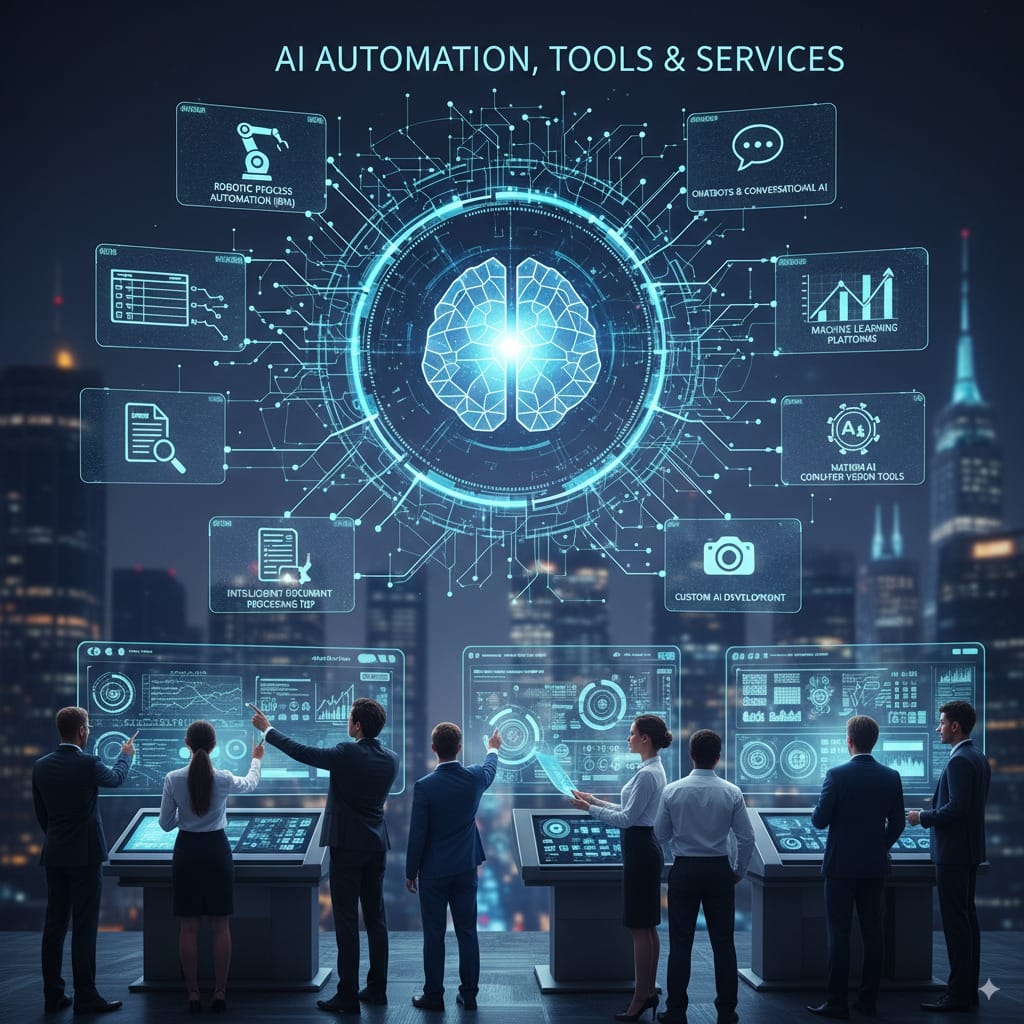A Guide to AI Tools & Services

That's a great topic! Here's a possible outline and some ideas for an article on "AI Automation, Tools & Services," along with a few spots where an image could really enhance the content:
Article Title Ideas:
- Unlocking Efficiency: The Power of AI Automation, Tools & Services
- Beyond Hype: Practical AI Automation for Business Growth
- Your AI Toolkit: Navigating Automation, Tools & Services
- The Future is Automated: A Guide to AI Tools & Services
Article Outline:
I. Introduction: The AI Automation Revolution
- Hook: Start with a relatable problem businesses face (e.g., repetitive tasks, data overload, slow decision-making).
- Introduce AI Automation as the solution.
- Briefly define what AI automation entails (using AI to perform tasks with minimal human intervention).
- Thesis Statement: AI automation, supported by powerful tools and services, is no longer a futuristic concept but a present-day necessity for competitive businesses.
II. What is AI Automation?
- Defining AI Automation:
- Explain the core concept: AI-driven systems performing tasks automatically.
- Distinguish from traditional automation (e.g., RPA) by highlighting AI's cognitive abilities (learning, decision-making, natural language understanding).
- Key benefits: Increased efficiency, reduced errors, cost savings, freeing up human potential.
III. The Landscape of AI Automation Tools
- Categories of Tools:
- Robotic Process Automation (RPA) with AI: Tools that mimic human actions but are enhanced with AI for more complex decisions. (e.g., UiPath, Automation Anywhere)
- Intelligent Document Processing (IDP): AI for extracting data from unstructured documents. (e.g., ABBYY, Hyperscience)
- Chatbots & Conversational AI: For customer service, internal support, and lead generation. (e.g., Drift, Intercom, custom-built solutions)
- Machine Learning Platforms: For data analysis, predictive modeling, and custom AI solutions. (e.g., Google AI Platform, Azure ML, AWS SageMaker)
- Natural Language Processing (NLP) Tools: For text analysis, sentiment analysis, and content generation. (e.g., OpenAI's GPT models, Hugging Face)
- Computer Vision Tools: For image recognition, quality control, and security. (e.g., Google Cloud Vision, Amazon Rekognition)
IV. AI Automation Services: Beyond Just the Tools
- Why Services are Crucial:
- Not every business has in-house AI expertise.
- Services help with strategy, implementation, and ongoing management.
- Types of Services:
- Consulting & Strategy: Helping businesses identify where AI can add the most value.
- Implementation & Integration: Setting up AI tools and integrating them with existing systems.
- Custom AI Development: Building bespoke AI models and applications for unique needs.
- Managed AI Services: Outsourcing the management and optimization of AI systems.
- Training & Support: Ensuring staff can effectively use and benefit from AI solutions.
V. Benefits of Embracing AI Automation
- Increased Operational Efficiency: Faster processes, higher throughput.
- Cost Reduction: Lower labor costs, fewer errors.
- Improved Accuracy & Consistency: AI doesn't get tired or make human errors.
- Enhanced Customer Experience: Faster responses, personalized interactions (e.g., chatbots).
- Better Decision-Making: AI provides insights from vast datasets.
- Scalability: Easily scale operations up or down as needed.
- Innovation: Freeing up human employees to focus on strategic and creative tasks.
VI. Challenges and Considerations
- Initial Investment: Cost of tools and services.
- Data Quality: AI is only as good as the data it's trained on.
- Integration Complexities: Integrating new AI systems with legacy infrastructure.
- Skill Gap: Need for skilled personnel to manage and optimize AI.
- Ethical Implications: Bias in AI, job displacement concerns.
- Security & Privacy: Protecting sensitive data handled by AI systems.
VII. How to Get Started with AI Automation
- Identify Pain Points: Where are manual processes slowing things down or causing errors?
- Start Small: Pilot projects to demonstrate ROI.
- Assess Data Readiness: Ensure you have quality data.
- Choose the Right Tools & Partners: Don't go it alone if you lack expertise.
- Focus on Business Value: What outcomes are you trying to achieve?
- Continuous Learning & Adaptation: AI is an evolving field.
VIII. Conclusion: The Future is Automated and Intelligent
- Recap the main benefits and importance of AI automation.
- Reiterate that AI automation is accessible through a growing ecosystem of tools and services.
- Final thought: Businesses that embrace AI automation will be the leaders of tomorrow.
